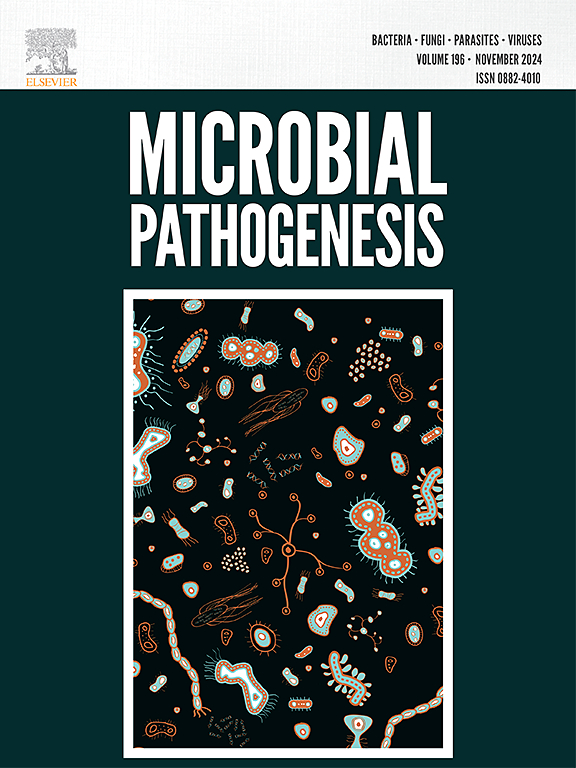马红球菌噬菌体ReT1的分离及其抑菌效果的研究。
IF 3.3
3区 医学
Q3 IMMUNOLOGY
引用次数: 0
摘要
近年来,耐多药马红球菌在全球范围内出现。作为抗生素的替代品,噬菌体疗法再次引起了人们的关注。在这项研究中,我们的目的是分离和维持马r.c i噬菌体,并将其作为一种潜在的噬菌体治疗马r.c i感染的药物。用丝裂霉素C从马马疟原虫Kuma83-10株中诱导出具有裂解活性的噬菌体ReT1,基因组分析显示其具有噬菌体样序列。ReT1在诱导后立即表现出两种斑块类型,克隆的命名为ReT1v-1和ReT1v-2。这些噬菌体可以在实验室中维持而不降低滴度,在形态上是siphoviridae样噬菌体,并且在预期用作噬菌体治疗的环境条件下是稳定的。ReT1v-2被改变为缺少ReT1v-1基因组中整合酶基因周围区域的裂解噬菌体。这两种噬菌体在宿主范围上没有差异(范围很窄),即在18株被检菌株中,仅在马氏R. JID03-27中形成斑点。而ReT1v-2对感染培养巨噬细胞的JID03-27::pVAPA菌株的杀菌作用最为显著。这一结果在体内是一致的,ret1v -2处理组在小鼠中表现出生长抑制。收集到更多对马链球菌具有溶原活性且具有不同特征的噬菌体,将为预测耐药性提供更多的噬菌体鸡尾酒配方选择。这项研究的结果支持了基于这些噬菌体开发配方的可能性。本文章由计算机程序翻译,如有差异,请以英文原文为准。
Isolation of Rhodococcus equi bacteriophage ReT1 and investigation of its bactericidal effect
In recent years, multidrug-resistant Rhodococcus equi has emerged globally. Phage therapy has been attracting renewed attention as an alternative to antibiotics. In this study, we aimed to isolate and maintain R. equi bacteriophages and characterize them as a potential agent for phage therapy to treat R. equi infection. Phages with lytic activity, ReT1, were induced with mitomycin C from R. equi Kuma83-10 strain that genomic analysis revealed to possess phage-like sequences. ReT1 showed two plaque types immediately after induction, and the cloned ones were designated ReT1v-1 and ReT1v-2. These phages could be maintained in the laboratory without titer reduction, were morphologically Siphoviridae-like phages, and were stable under the environmental conditions expected for use as phage therapy. ReT1v-2 was altered into a lytic phage lacking the region around the integrase gene from the ReT1v-1 genome. Both phages did not differ in their host range (narrow range), that is, formed spots only in R. equi JID03-27, of the 18 strains examined. However, ReT1v-2 showed the most pronounced bactericidal effect against JID03-27:pVAPA strains, which infected cultured macrophages. This result was consistent in vivo, with the ReT1v-2-treated group showing growth inhibition in mice. The collection of more phages with lysogenic activity against R. equi and with different characteristics will lead to more options for phage cocktail formulations in anticipation of resistance. The results of this study support the possibility of developing formulations based on these phages.
求助全文
通过发布文献求助,成功后即可免费获取论文全文。
去求助
来源期刊

Microbial pathogenesis
医学-免疫学
CiteScore
7.40
自引率
2.60%
发文量
472
审稿时长
56 days
期刊介绍:
Microbial Pathogenesis publishes original contributions and reviews about the molecular and cellular mechanisms of infectious diseases. It covers microbiology, host-pathogen interaction and immunology related to infectious agents, including bacteria, fungi, viruses and protozoa. It also accepts papers in the field of clinical microbiology, with the exception of case reports.
Research Areas Include:
-Pathogenesis
-Virulence factors
-Host susceptibility or resistance
-Immune mechanisms
-Identification, cloning and sequencing of relevant genes
-Genetic studies
-Viruses, prokaryotic organisms and protozoa
-Microbiota
-Systems biology related to infectious diseases
-Targets for vaccine design (pre-clinical studies)
 求助内容:
求助内容: 应助结果提醒方式:
应助结果提醒方式:


